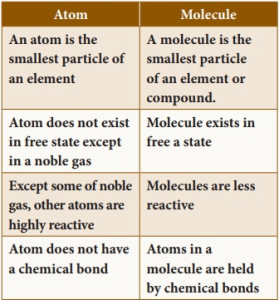Difference between Atom and Molecule


The Basic Difference between atom and molecule that An atom is considered the smallest constituent unit of matter that preserves the properties of a chemical element, regardless of its state, each element is composed of neutral or ionized atoms. For chemistry, a molecule is an electrically neutral and stable group of at least two atoms held together by strong chemical bonds.
Atom
The term atom comes from the Greek atom which is the union of two words, “an” which means without and “tomon” which means union, this defines the atom as that which cannot be divided. It was the name that Democritus gave to the particles that he conceived as the smallest.
An atom is the smallest constituent unit of matter and it preserves the properties of the element it composes. Neutral or ionized atoms are found in every gas, solid, liquid, and plasma. They are very small with typical sizes of 100 pm.
They do not have defined limits and their size is defined by different but close values. Atomic models plus quantum principles are required to explain and predict their behavior since their small size implies that their study through classical physics offers incorrect results.
Each atom contains a nucleus and one or more electrons orbiting it. The nucleus is made up of protons and neutrons. Most of the mass of an atom is in the nucleus.
Electrons have a negative electric charge, protons have a positive charge, and neutrons contain both charges, being neutral. An atom with an equal number of electrons and protons is neutral, while if it has a greater number of electrons or protons, it will have a negative (anion) or positive (cation) electrical charge respectively, and is now known as an ion.
Molecule
A molecule is an electrically neutral and stable group of at least two atoms bonded through strong chemical bonds in a defined configuration. Inorganic chemistry and biochemistry, the term is used for organic compounds and biomolecules.
A molecule can be made up of several atoms of a single chemical element or of different elements. Those atoms and complexes linked by non-covalent bonds such as hydrogen or ionic bonds are not considered molecules.
A molecule is considered to be the smallest part of a chemical that retains its chemical properties.
Types of molecules
- Discrete molecules.
- Macromolecules or polymers.
- Atoms are the smallest constituent of matter.
- Molecules are made up of atoms different from each other or belonging to the same element.
- An atom cannot be independent in nature.
- A molecule can be in nature independently.
Related Post
Recent Posts
Chatspin Mod APK
On your smartphone or tablet, Chatspin Mode APK is a simple method to meet new…
Ver Peliculas Pro APK
Ver Peliculas Pro Apk you can find your favorite movies whenever you want with Latin,…
Clash of Magic Apk
When we discussed this particular gaming app we found the gameplay to be rich in…
Flex IPTV APK
Flex IPTV Apk allows you to view live and non-live TV via IPTV-based streaming technologies.…
Mohak TV APK
Mohak TV APK is a program that supports Turkey. So you have no choice. But…